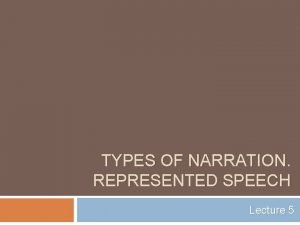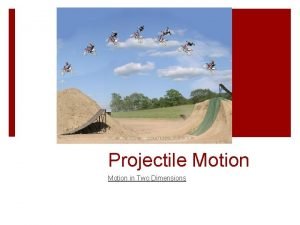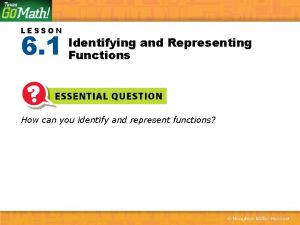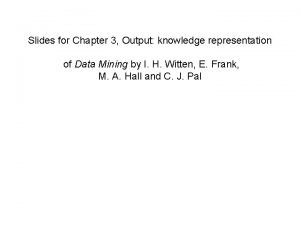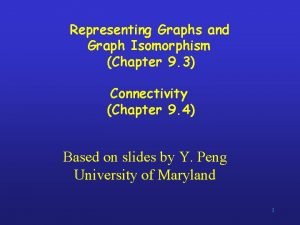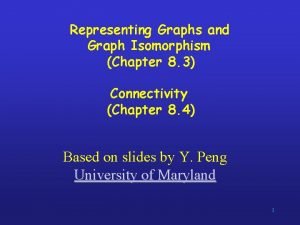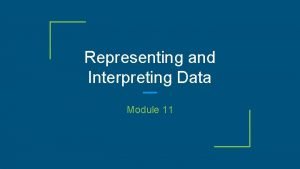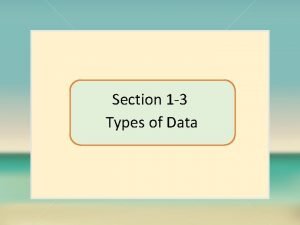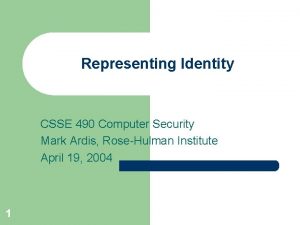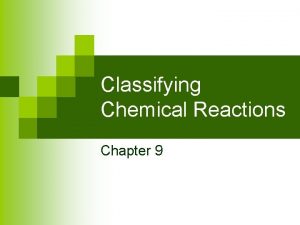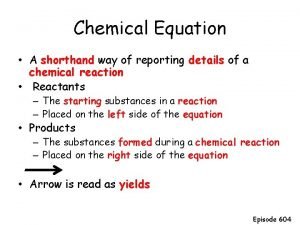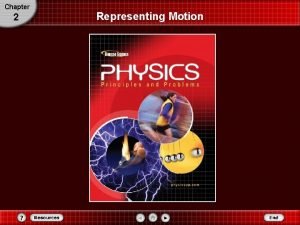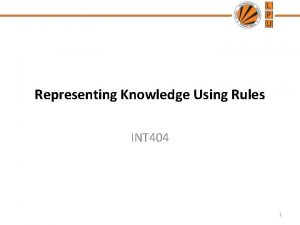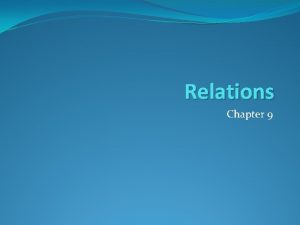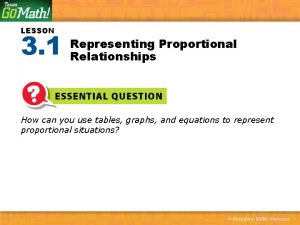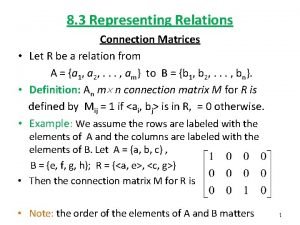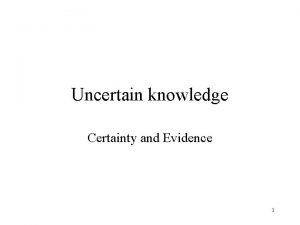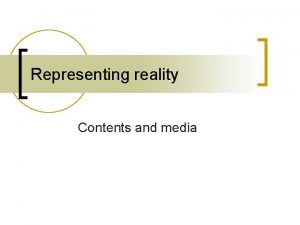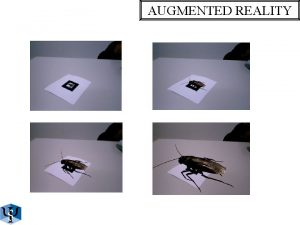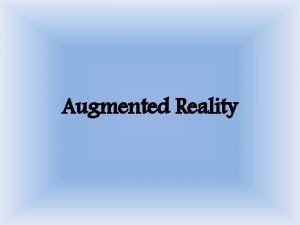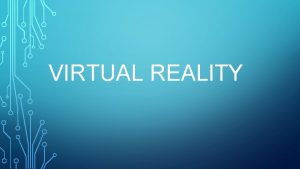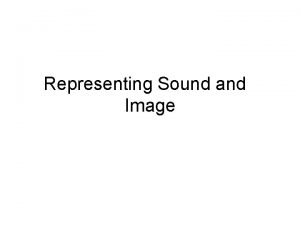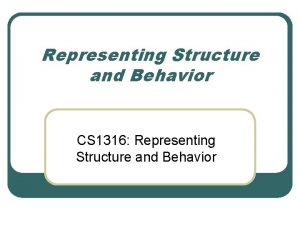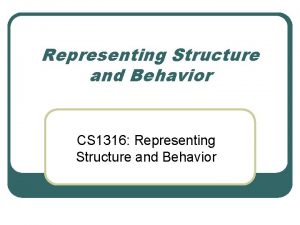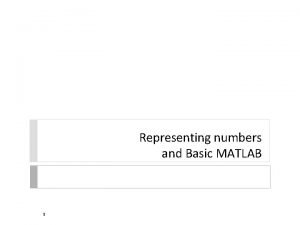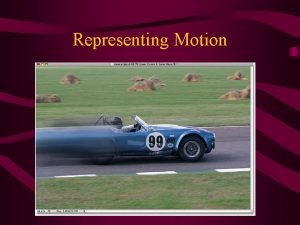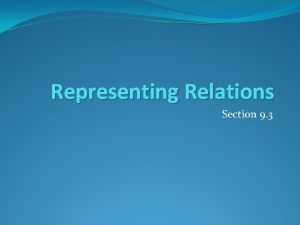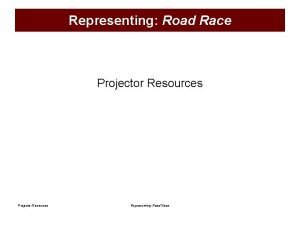Representing reality Contents and media What is reality






















- Slides: 22

Representing reality Contents and media

What is reality? n Materialist notions of reality ¡ n Subjectivist notions of reality ¡ n A unique, external, physical universe A purely imaginary concept projected from consciousness with either no physical referent or an unknowable one Interactivist notions of reality ¡ Posits reality as a collision between an only partially knowable physical external world and the mental constructs that give it meaning

Ontology n Our culture accepts a materialist vision of reality ¡ ¡ While we may not have a perfect notion of reality, it is based on mistakes we make in recognizing the true nature of reality Though human ability to understand/ perceive is limited, “The Truth is Out There”

Representation n n Media provide words, icons, pictures, etc. that ‘stand in’ for features of the ‘real world’ The veracity or validity of the representations is judged according to their ‘reflection’ of those real things they are supposed to represent

Representation n But what if the representation is itself what is real and there is no ‘thing’ it represents? What if there is a physical thing but it has no meaning until it is represented, that is, worked on by consciousness so that it becomes something? Does reality become something different if our sense organs change?

What reality does a media text represent? n n n The ‘real world’ as it is Real time, geography with unreal characters and events A plausible imaginary world and characters A fantasy world with plausible characters A fantasy world with fantastic characters Concepts that do not fit our notions of people and places

Two concepts of ‘realism’ n n The relative veracity of the story with regard to its representation of a materialist reality A set of conventions in the production of a text that influence the awareness of the audience member of the process of narrative construction

Realism is not always seen as a good thing n On occasion, the attempt is made to present the story as fantasy ¡ ¡ ¡ Want a sort of magical feeling Want the audience to experience the narrative as pure escape Could want the natural and mundane world to be seen as fantastic

Media artists often go to great effort to make their texts realistic n n Hire historians, cops, members of groups Continuity Pre-testing Special effects

Features of the presentation that affect its ‘realism’ n n n Continuity Technical quality Characteristics of the medium ¡ Modalities of perception: Sound, video, motion, linguistic, etc.

The Reelization of Reality n n n “The drive behind the need to create a strong perceptual reality, particularly in referentially unreal productions, is difficult to pin down. Charles and Mirella Affron discuss what they term the ‘Reality Effect’—a notion of perceptual reality which asserts that sets must look real enough that people who have been to the actual location they replicate might think the films were shot on location. ” “vast majority of feature films” seek reality effect “Speaking historically of several movies about New York, they suggest that in these films the narrative ‘would have suffered drastically’ had the sets not seemed true to life. ”

Jurassic Park drew upon both visual references and plot elements the audience would be familiar with. The dinosaurs weren’t just the same size and color as the viewers might have expected from their childhood trips to museums, but had their computer-generated skin (designed after everyday lizards’) carefully mapped to interact with their computer-generated muscles and bones. To breed further familiarity with the audience’s experience with actual animals, the dinosaurs ran and moved in patterns carefully copied from real-life quadrupeds.

n The visuals were not the only element to benefit from perceived reality cues: Spielberg said, ‘The credibility of the premise—that dinosaurs could come back to life through cloning of the DNA of fossil mosquitos trapped in amber— is what allowed the movie to be made. ’

Jim Cameron n “In T 2 and Jurassic Park, computer animation was being used to solve a realworld photographic problem, and so the audience didn’t question the reality of the images. Film is inherently kind of not real, and the films that succeed best are the ones that start by creating a world or characters or whatever that say: this is real, this is real--and they keep coming at you every moment the actors are working, and every bit of production design is trying to underline in red that it’s real. ”

Technology and realism

n “Virtual reality will prove to be a more compelling fantasy world than Nintendo--but even so, the real power of the Head-Mounted Display is that it can help you perceive the real world in ways that were previously impossible. To see the invisible, to travel at the speed of light, to shrink yourself into microscopic worlds, to relive experiences--these are the powers that the head-mounted display offers you. Though it sounds like science fiction today, tomorrow it will seem as commonplace as talking on the telephone. ”

Are ‘natural’ and ‘real’ the same? n The ‘real’ in realistic presentation has as much to do with culturally learned expectations as with capture of ‘true’ or ‘natural’ action, objects, etc. ¡ ¡ n Color, sound effects, etc. may need to be enhanced in order to generate a ‘realistic’ representation Time is often distorted (compressed) to make it more compatible with audience expectations as well as to work with the story Actually, ‘natural’ presentation (start the camera and walk away) often is experienced as ‘less real’ than doctored ¡ It is often hard to hear dialogue, etc. because of ambient sound

Realist presentations n n n Representation is supposed to ‘stand in’ for the actual events and objects The work of representation is hidden from view. That is, you should not be aware of all the technology, decision-making, etc. that went into telling the story—it should seem as though you are a fly on the wall actually watching real events unfold.

n “Judith Mayne points out that “the cinema depends upon an unquestioned relationship between image and the real, as the novel depends upon a similar relationship between language and the real. ””

Features of realist presentation n n Third-person narration Narrator/audience omniscience Camera work edited to be unobtrusive Actors, etc. never directly address audience n n “Fourth wall” Treatment of actions as displaying certainty—no discussion of likelihood, probability, etc.

Hall’s dimensions of ‘reality’ n Alice Hall studied college students’ evaluations of the realism of media texts ¡ n Focus groups Identified 6 “means of evaluating the realism of media texts” ¡ ¡ ¡ Plausibility Typicality Factuality Emotional involvement Narrative consistency Perceptual persuasiveness

Beliefs about the impact of media realism n Enhances audience involvement ¡ n n n Emotional connection with characters Increases learning Increases enjoyment Increases effect ¡ ¡ Violence Attitude change
 Type of speech style
Type of speech style Representing comparing and ordering decimals
Representing comparing and ordering decimals Vector arrows representing the vx and vy
Vector arrows representing the vx and vy Identifying and representing functions homework answer key
Identifying and representing functions homework answer key Representing input data and output knowledge
Representing input data and output knowledge Representing graphs and graph isomorphism
Representing graphs and graph isomorphism Representing graphs and graph isomorphism
Representing graphs and graph isomorphism Representing and interpreting data
Representing and interpreting data Two step flow theory
Two step flow theory Statistic vs parameter example
Statistic vs parameter example Mark ardis
Mark ardis Rikkwa floral design
Rikkwa floral design Animals representing chaos
Animals representing chaos A chemists shorthand way of representing chemical reaction
A chemists shorthand way of representing chemical reaction Chemist shorthand way of representing chemical reaction
Chemist shorthand way of representing chemical reaction Representing motion
Representing motion Chemist shorthand way of representing chemical reaction.
Chemist shorthand way of representing chemical reaction. Representing knowledge using rules
Representing knowledge using rules Representing relations using digraphs
Representing relations using digraphs Lesson 3 representing proportional relationships
Lesson 3 representing proportional relationships Representing relations using digraphs
Representing relations using digraphs Function can be represented
Function can be represented Representing knowledge in an uncertain domain
Representing knowledge in an uncertain domain
